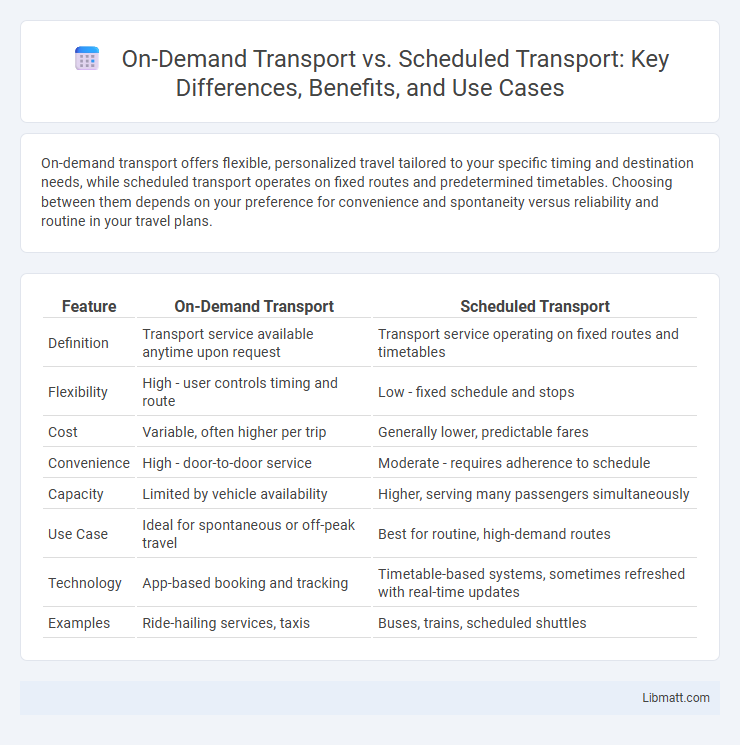On-demand transport offers flexible, personalized travel tailored to your specific timing and destination needs, while scheduled transport operates on fixed routes and predetermined timetables. Choosing between them depends on your preference for convenience and spontaneity versus reliability and routine in your travel plans.
Table of Comparison
| Feature | On-Demand Transport | Scheduled Transport |
|---|---|---|
| Definition | Transport service available anytime upon request | Transport service operating on fixed routes and timetables |
| Flexibility | High - user controls timing and route | Low - fixed schedule and stops |
| Cost | Variable, often higher per trip | Generally lower, predictable fares |
| Convenience | High - door-to-door service | Moderate - requires adherence to schedule |
| Capacity | Limited by vehicle availability | Higher, serving many passengers simultaneously |
| Use Case | Ideal for spontaneous or off-peak travel | Best for routine, high-demand routes |
| Technology | App-based booking and tracking | Timetable-based systems, sometimes refreshed with real-time updates |
| Examples | Ride-hailing services, taxis | Buses, trains, scheduled shuttles |
Understanding On-Demand Transport
On-demand transport provides flexible, real-time travel options tailored to individual passenger requests, contrasting with scheduled transport's fixed routes and timetables. This model leverages mobile apps and GPS technology to optimize routes dynamically, reducing wait times and improving service efficiency. Understanding on-demand transport is crucial for urban planners aiming to enhance mobility, reduce congestion, and meet evolving commuter needs.
What Is Scheduled Transport?
Scheduled transport refers to public or private transit services operating on fixed routes and timetables, such as buses, trains, and subways running at predetermined times. This system ensures consistent availability and reliability by adhering to a set schedule, allowing passengers to plan their trips in advance. Scheduled transport optimizes resource allocation and serves high-demand areas efficiently with predictable service intervals.
Key Differences: On-Demand vs Scheduled Transport
On-demand transport offers flexible, user-initiated rides that adapt to real-time requests, contrasting with scheduled transport's fixed routes and timetables designed for predictability and efficiency. On-demand services often utilize digital platforms and GPS technology to optimize routing and minimize wait times, whereas scheduled transport relies on consistent, pre-planned intervals to serve high-demand corridors. These key differences highlight on-demand transport's suitability for personalized, variable travel needs and scheduled transport's strength in managing large passenger volumes on established schedules.
Flexibility and Convenience Compared
On-demand transport offers superior flexibility, allowing passengers to request rides at any time without adhering to fixed routes or timetables, enhancing convenience for spontaneous travel needs. Scheduled transport operates on predetermined routes and schedules, which can limit adaptability but provides reliability for routine commutes. The dynamic routing in on-demand systems reduces wait times and aligns with user preferences, whereas scheduled services benefit from consistent availability during peak hours.
Cost Implications of Each Transport Mode
On-demand transport typically incurs higher operational costs due to variable routing and lower passenger density, which results in increased fuel consumption and driver hours. Scheduled transport benefits from economies of scale and route optimization, reducing per-passenger costs through consistent scheduling and higher occupancy rates. However, on-demand services may lower overall expenses by minimizing wait times and providing flexible routing that can reduce unnecessary trips.
Technology’s Role in Transport Evolution
Technology's role in transport evolution is pivotal in enhancing both on-demand and scheduled transport systems through real-time data analytics, GPS tracking, and mobile app integration. On-demand transport leverages AI algorithms and dynamic routing to offer flexible, user-centric mobility, reducing wait times and improving vehicle utilization. Scheduled transport benefits from advanced scheduling software and IoT-enabled fleet management that optimize route efficiency and maintain service reliability.
Environmental Impact: Which Is Greener?
On-demand transport systems often result in fewer empty trips and reduced wait times, leading to lower overall emissions compared to fixed-route scheduled transport, which can suffer from underutilized capacity during off-peak hours. Your choice of on-demand services powered by electric or hybrid vehicles further minimizes the carbon footprint by optimizing routes dynamically and reducing fuel consumption. While scheduled transport offers predictable service, its environmental benefits depend largely on passenger load factors and the energy sources of the fleet.
Use Cases: Ideal Scenarios for Each Option
On-demand transport excels in urban areas with fluctuating passenger volumes, such as late-night rides or event-based travel, providing flexibility and reduced wait times. Scheduled transport is ideal for high-density commuter corridors and fixed routes, ensuring reliability and predictable service for daily work or school trips. Both systems optimize resource allocation by matching service frequency to specific demand patterns, enhancing efficiency in public transit networks.
Challenges and Limitations
On-demand transport faces challenges including higher operational costs and complex route optimization due to unpredictable demand patterns. Scheduled transport struggles with inflexibility, often leading to underutilized capacity during off-peak hours and overcrowding at peak times. Both systems encounter limitations in scalability and adapting to fluctuating passenger needs and traffic conditions.
Future Trends in Passenger Transport
On-demand transport systems leverage real-time data and advanced algorithms to provide flexible, efficient mobility solutions adapting to passenger needs, contrasting with fixed-route scheduled transport's predetermined timetables. Emerging trends include integration with autonomous vehicles and AI-driven route optimization, enhancing convenience and reducing wait times in urban environments. Future passenger transport prioritizes sustainability and user-centric experiences, blending the scalability of scheduled services with the responsiveness of on-demand networks.
on-demand transport vs scheduled transport Infographic

 libmatt.com
libmatt.com